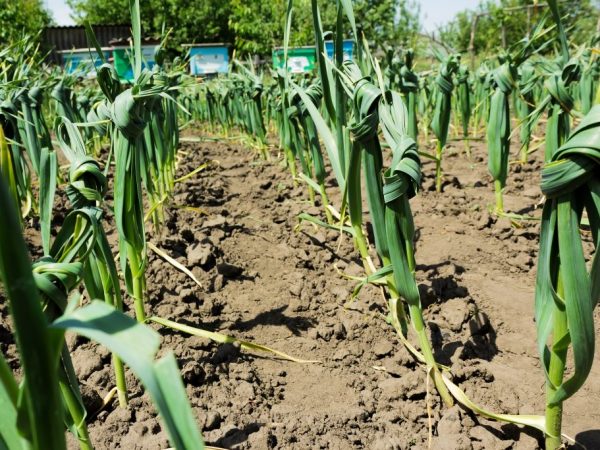When to tie garlic
Getting a bountiful harvest is the main goal of vegetable gardens. The tying procedure helps to increase the fertility of garlic. For the correct manipulation, you must clearly follow the rules. The main thing is to know when to tie the garlic and why to do it.

Rules for tying garlic
The need for tying
Timely tying of the garlic leaves prevents the accumulation of all minerals in the bulb. A young plant will direct its forces towards the formation of a large, healthy bulb, and will not waste energy on growing green shoots.
The question is whether you need to tie the garlic. It is difficult to achieve ideal conditions in the garden, so tying garlic leaves is necessary. This ensures the correct formation of the bulb, which guarantees a rich and healthy harvest.
Subtleties of the procedure
How to tie garlic correctly so as not to harm the plant? Before carrying out the garter procedure, remove the arrow. To leave a few arrows for the subsequent formation of planting material, tying the leaves is contraindicated.
To remove the arrow, use a knife, and after trimming, sprinkle the wound (breakage point) with crushed coal. The importance of filling the wound with carbon powder is explained by its ability to prevent the development of infectious diseases, as well as damage by pests.
Garlic leaves are tied, paying attention to their length. If it does not exceed 35 cm, one knot is enough. When the leaves reach the 40 cm mark, they should be tied with a double knot.
To properly tie the leaves, select a few middle leaves, twist them and form a knot. Be sure to monitor its tightness, overtightening the leaves you can damage or break them.
Some gardeners prefer to weave braids rather than knots, but this method takes more time and effort. As a result, the leaves are tied in a tight knot, but not damaged.
The work must be carried out with heavy gloves. The sprouts have sharp edges and the ability to cause irritation or allergic reactions.
Time frame

By tying, strong bulbs grow
It is equally important to understand when to tie the garlic leaves. Winter varieties, planted in autumn, are tied starting from the second week of July, approximately 4-6 days before harvest. Spring varieties ripen by the end of summer, so the set is formed a week before the planned harvest.
A more accurate time is determined based on the state of the leaves of the vegetable: the foliage acquires a yellowish tint, after which the bulbs crack, and the upper shoots gradually tilt towards the ground.
Harvesting
Harvesting of ripe fruits subjected to the garter procedure is performed a few days earlier. This is due to the fact that the abundance of juice allows the bulb to form faster. The degree of maturity is determined by digging up individual specimens: in mature heads, the husk easily leaves the fruit.
It is important to harvest on time, because long-term storage will lead to a loss of taste and a violation of the structure of the head - the cloves will begin to fall apart.
Signs of maturity:
- durable husk that protects the plant from pests;
- dense teeth;
- the size of the bulb meets the standards;
- it is easy to separate the husk from the head, but the cloves do not disintegrate.
Digging is carried out at a minimum moisture level. Summer evening is the best time to check maturity.
Digging rules: pry the garlic with a pitchfork, clean it from the ground, dry it. The leaf is trimmed after the fruit is completely dry.
Conclusion
Whether it is necessary to tie the garlic is an individual question, but practice shows that plantings that have undergone a garlic are formed and ripen faster. This allows you to get more harvest in a minimum time. If all the above rules are observed, the risk of damage to the fruit will be excluded.

